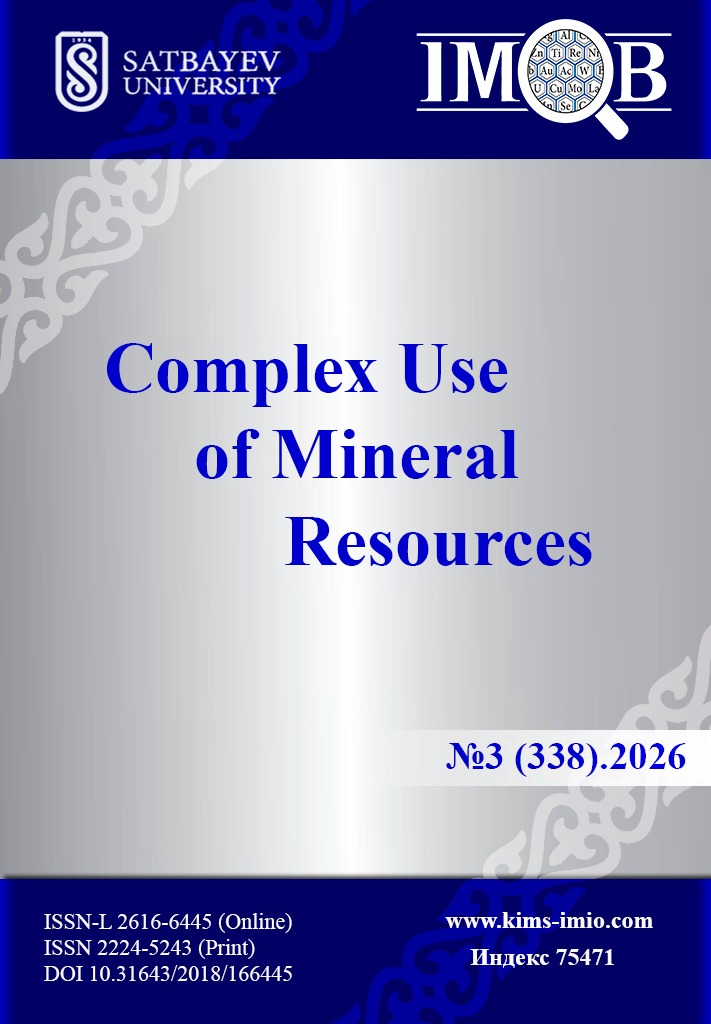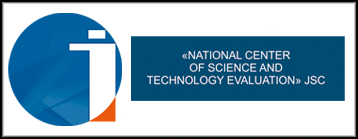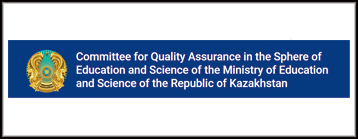Study of rock mass structural features based on laser scanning results
DOI:
https://doi.org/10.31643/2026/6445.30Keywords:
laser scanning, geospatial data, digital terrain model, kinematic analysis, pit, rock mass structure.Abstract
Monitoring of pit slopes benches stability and pit walls plays the important role in the safety of mining operations. Slope stability assessment and risk management are mandatory to ensure safe and efficient operation of pits. Laser scanning technology is one of the base methods of geospatial data collecting for building of man-made objects models. Laser scanning is widely used in mining when performing survey work, measurements, monitoring, and studying structural features on the outcroppings of the rock mass. The article describes the technological chain: the collection of geospatial data, the processing of the obtained data with the construction of a terrain model and the further use of the resulting model to solve practical tasks. The choice of optimal laser scanning parameters should be based on the technological features of a pit, the technical characteristics of used equipment and scanning density required to solve the tasks. The article demonstrates the use of the obtained model for determining the necessary geometric parameters of the structural features of the rock mass to conduct kinematic analysis of potential bench failures at the object of study. Based on the results of kinematic analysis, recommendations were developed for further mining operations and potential bench failures risks reducing. The proposed technology can be used and adapted for laser scanning, followed by the construction of a terrain model at various mineral deposits to solve a wide range of tasks and ensure the safety of open-pit mining. Due to the inclusion of laser scanners in the register of measuring instruments in Kazakhstan, high reliability of measurement accuracy is ensured. The technology allows both to obtain generalized data on the sides of the quarry, as well as detailed scans of individual ledges. A significant advantage is the automatic generation of a point cloud during scanning, which reduces in-house processing.
Downloads
References
Kosarev N, Goldobin D, Sermiagin R, Kemerbayev N, Sholomitskii A. Evaluation of the high-degree global gravity field models in the territory of Kazakhstan. International Journal of Engineering and Geosciences. 2025; 10(1):14-21. https://doi.org/10.26833/ijeg.1485621
Moser DV, Levin E, Satbergenova AK. The research study in the convergence of the results of processing radar images sentinel-1a with field observations of agricultural sites. Geodesy and cartography. 2019; 950(8):52–58. http://doi.org/10.22389/0016-7126-2019-950-8-52-58
Alipbeki O, Grossul P, Rakhimov D, Kupidura P, Alipbekova C, Musaif G, Turekeldiyeva R, Augambaev K, Begaliyeva M. Ecosystem Health Assessment of the Zerendy District, Kazakhstan. Sustainability. 2025, 17(1):277. https://doi.org/10.3390/su17010277
Alipbeki O, Alipbekova C, Mussaif G, Grossul P, Zhenshan D, Muzyka O, Turekeldiyeva R, Yelubayev D, Rakhimov D, Kupidura P, Aliken E. Analysis and Prediction of Land Use/Land Cover Changes in Korgalzhyn District, Kazakhstan. Agronomy. 2024; 14:268. https://doi.org/10.3390/agronomy14020268
Renato Macciotta. Slope risk management in light of uncertainty and environmental variability-2021 Canadian Geotechnical Colloquium. Canadian Geotechnical Journal. 2023; 60(12):1777-1791. https://doi.org/10.1139/cgj-2022-0626
Bilgehan Kekeç, Niyazi Bilim, Emre Karakaya, Dhikra Ghiloufi. Applications of Terrestrial Laser Scanning (TLS) in Mining: A Review. Turkey Lidar Journal. 2021; 3(1):31-38. https://doi.org/10.51946/melid.927270
Sokalski D, Wojewoda J. Comparison of the consistency of structural measurements made using the traditional method and with the use of point cloud from terrestrial laser scanning in a selected site of Radków Bluff (Table Mountains, SW-Poland). Landform Analysis. 2023; 42:37-49. https://doi.org/10.12657/landfana-042-003
Xu Z, Xu E, Wu L, Liu S, Mao Y. Registration of Terrestrial Laser Scanning Surveys Using Terrain-Invariant Regions for Measuring Exploitative Volumes over Open-Pit Mines, Remote sensing. 2019; 11(6):606. https://doi.org/10.3390/rs11060606
Druz RA, Protasova AV, Ohunov ShR, Kshanovskaja AV. Comparison of airborn laser scanning and aerial survey using unmanned air vehicles. Mining Informational and Analytical Bulletin. 2023; 5:130-14. https://doi.org/10.25018/0236_1493_2023_5_0_130
Tan Y, Liu X, Jin S, Wang Q, Wang D, Xie XA. Terrestrial Laser Scanning-Based Method for Indoor Geometric Quality Measurement. Remote Sensing. 2024; 16(1):59. https://doi.org/10.3390/rs16010059
Nizametdinov FK, Baryshnikov VD, Zhanatuly E, Nagibin AA, Tuyakbai AS, Nizametdinov NF, Estaeva AR. Selection and Justification of Design Variables for Strength Properties of Rocks in Slope Stability Analysis for Open Pits. Journal of Mining Science. 2021; 57:386-392. https://doi.org/10.1134/S1062739121030042
Bagaraja Sirait, Silti Salinita, Zulfahmi, Eko Pujianto. Assessing slope failure in coal mining using kinematic analysis, IOP Conference Series: Earth and Environmental Science. International Seminar on Mineral and Coal Technology, Bandung. 2021; 882:012060. https://doi.org/10.1088/1755-1315/882/1/012060
Ozdogan MV, Deliormanli AH. Determination of possible failure surfaces in an open-pit slope caused by underground production. Bulletin of Geophysics and Oceanography. 2020; 61(2):199-218. https://doi.org/10.4430/bgta0305
David Saiang. Back Analysis of Narrow Vein Open Stope Stability and Verification Using Kinematic and Empirical Methods. Proceedings of the Rocscience International Conference. 2023. https://doi.org/10.2991/978-94-6463-258-3_3
Liu W, Sheng G, Kang X, Yang M, Li D, Wu S. Slope Stability Analysis of Open-Pit Mine Considering Weathering Effects. Applied Sciences. 2024; 14:8449. https://doi.org/10.3390/app14188449
Xu S, Wang B, Wang D, Zhang J. A practical stability/instability chart analysis for slope large deformations using the material point method. Engineering Geology. 2024; 338:107611. https://doi.org/10.1016/j.enggeo.2024.107611
Christian Obregon, Hani Mitri. Probabilistic approach for open pit bench slope stability analysis – A mine case study. International Journal of Mining Science and Technology. 2019; 29(4):629-640. https://doi.org/10.1016/j.ijmst.2019.06.017
Duncan C. Wyllie, Christopher W. Mah. Rock slope engineering (4th Edition). Taylor & Francis e-Library. 2005.
Hudson JA, Harrison JP. Engineering rock mechanics. An introduction to the principles. Elsevier Science. 2000.
Agyei G, Ocran L, Buaba EM. Slope Angle Estimation Of Amoanda East Pit Of Abosso Gold Fields, Ghana. Nigerian Journal of Technology. 2019; 38(3):594-602. http://dx.doi.org/10.4314/njt.v38i3.8
Yi He, Junyan Yu, Ran Yuan, Wenfa Wang, Nikolaos Nikitas. Stability and failure mechanisms in three-dimensional cracked slope: Static and dynamic analysis. Computers and Geotechnics. 2022; 144:104626. https://doi.org/10.1016/j.compgeo.2021.104626
Lu Y, Chen X, Wang L. Research on Fracture Mechanism and Stability of Slope with Tensile Cracks. Applied Sciences. 2022; 12:12687. https://doi.org/10.3390/app122412687
Yi He, Yan Liu, Yingbin Zhang, Ran Yuan. Stability assessment of three-dimensional slopes with cracks. Engineering Geology. 2019; 252:136-144. https://doi.org/10.1016/j.enggeo.2019.03.001
Nizametdinov NF, Baryshnikov VD, Nagibin AA, Nizametdinov RF, Tuyakbay AS. Justification of Pitwall Parameters: A Case-Study of Koktaszhal Deposit, Kazakhstan. Journal of Mining Science. 2022; 58:527-533. https://doi.org/ 10.1134/S1062739122040019
Downloads
Published
How to Cite
Issue
Section
License
Copyright (c) 2025 V.F. Yartseva, D.S. Ozhigin, V.N. Dolgonosov, S.B. Ozhigina, S.G. Ozhigin

This work is licensed under a Creative Commons Attribution 4.0 International License.


























